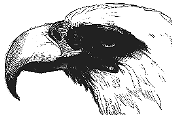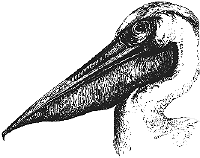
A bird's beak is basically a lightweight, bony elongation of its skull. The beak is covered with skin that produces keratin, the same material found in human fingernails and hair. On most birds, the keratin condenses and dries, forming the beak's hard, glossy, outer covering. The tip and cutting edges of the beak are constantly renewed as they wear away, just as human nails are.
Bird beaks are multi-functional tools. Birds use them to weave nests, defend their territory, attack competitors, groom feathers, communicate, and most significantly, to gather or capture food.
Over the years, a wide assortment of bird beaks has evolved. Though many birds have
straight beaks that are adapted to general feeding, some birds' beaks are examples of
unique adaptations. 
| Birds In The Basin |
Unusual Bird Beaks and Their Uses:
- Eagles and other raptors have strong, hooked beaks for tearing fish.
- Anhingas and herons have dagger-like bills for spearing and grasping fish and frogs.
- Pelicans have pouched beaks, used as nets for scooping up fish.
- Hummingbirds' beaks protect their long tubular tongues, with which the birds extract
nectar from flowers.

- Swallows and whippoorwills use their wide, gaping beaked mouths to catch flying insects in mid-air.
- Cardinals and grosbeaks have short, cone-shaped beaks for cracking open seeds.
- Snipes have long beaks for probing in mud and water to find worms and other small
animals.

- Woodpeckers have chisel-like beaks for searching under tree bark to find insects.
- Yellowbellied sapsuckers have drill-like beaks for boring into trees to feed on sap and the insects attracted to it.
All animals are adapted to their environment in unique ways. A very important adaptation for food gathering in birds is the size and shape of the beak. In this activity, we will focus on different types of bird beaks and discover how each type of beak functions in collecting specific types of food.
Students, using everyday objects that model different bird beaks, will try to gather the food and place it in their "stomachs". A class discussion on specialization of each beak type should follow.
| Materials: |
- Suggested Food Resources:
uncooked shell macaroni, goldfish crackers, M&MŽ candies, gummy worms, chocolate sprinkles, peanuts, sunflower seeds, raisins, mini-marshmallows, cereals (you get the idea!) For an interesting ending, try individual cups of pudding for each student! - Beaks (utensils): one set per group
clothespin, toothpick, straw, spoon, small plastic scoop, tweezers/small scissors - Other Materials:
paper plate for feeding dish (1 per group); small cup for stomach (1 per student), whistle/bell to signal change of feeding
| Instructions: |
Students should work in groups of 4-6, either at a table or around a clean mat on the floor. Distribute one type of "beak" (utensil) to each student, instructing them to hold it in one hand and place the other hand behind their back. Place a "stomach" (cup) in front of each student. Place one type of food in each group's feeding area (plate) and instruct students that, at your signal, they must compete for as much of that food resource as they can gather with their "beaks". Remind them that their survival depends on their ability to gather food. Give the signal, then allow each group 5-10 seconds to "feed". All food must go into their "stomach" (cups)! After 10 seconds, give the signal to stop. Have the students tell which beak was most successful in gathering that type of food. Repeat the procedure for each type of food available.
Extensions:
|
| Before & After: |
- Welcome to the Wetlands activity book: do activities "Birds of the Wetlands" I and II, and "Build-A-Bird" I and II.
- Have students bring in pictures of birds found in the Lake Pontchartrain Basin for a classroom display.
- Assign each student a different type of bird found in the Basin to research, particularly its beak type and the type of food it eats. Report to the class.
- Invite a speaker from the local Audubon Society to make a presentation to the class.
- Take the class bird-watching around the school grounds. Discuss their observations. Have students repeat this in their own neighborhood and share their observations with the class.
- Write syntu poetry about bird beaks. (Refer to Rainstorm Poetry for directions.)
- Make bird beak masks with construction paper.
- Read books or stories about birds to the class. Stellaluna provides interesting comparisons between lifestyles of birds and bats.
- Take a learning expedition to Turtle Cove Environmental Research Station, the Audubon Zoo, Bayou Sauvage National Wildlife Refuge, the Northlake Nature Center, parks or other sites suitable for observing large numbers of birds. Based on your observations of the birds you see, record and analyze the adaptations of five different types of birds.
- Build different types of bird feeders and hang them in the schoolyard for daily observation of feeding behaviors.
- Research other specific adaptations of birds, such as those required for locomotion, reproduction, or protection.
- Construct an ecological community in a shoebox, including birds specially adapted to that particular habitat. Set up an exhibit in the school library, or use them to make presentations for other classes.
- Write a short story: "The Bird I'd Most Like to Be".
- Compare and contrast fish with birds that live in water.
- Develop a student magazine on the class discoveries about bird adaptations.
- Write a riddle or poem about a kind of bird frequently seen in the Lake Pontchartrain Basin. Draw an outline of the bird and write the riddle or poem inside.
| Assessment: |
Students should be able to:
- Compare and contrast a variety of bird beaks.
- Describe how a beak is adapted to the type of food eaten by a bird species.
- Provide evidence for conclusions.
- Graph and interpret data.
- Design a beak for a specific function.
| References: |
Some of these activities have been adapted from,
- an activity titled "Bird Beak Buffet" by Rita Mae Alsup
- "Breakfast for the Birds", part of a publication printed for National Science and Technology Week, 1993-94.
- Banbury, M.M., London, K., Lyons, S. E., Reaves, D., Simons, L. N., Smith-Gratto, K., Thomas, P.J., & Wieberg, D. G. (1991). Welcome to the Wetlands: An Activity Book for Teachers. New Orleans: Louisiana Nature Center.
- Cannon, J. (1993). Stellaluna, Harcourt Brace, New York, N.Y.